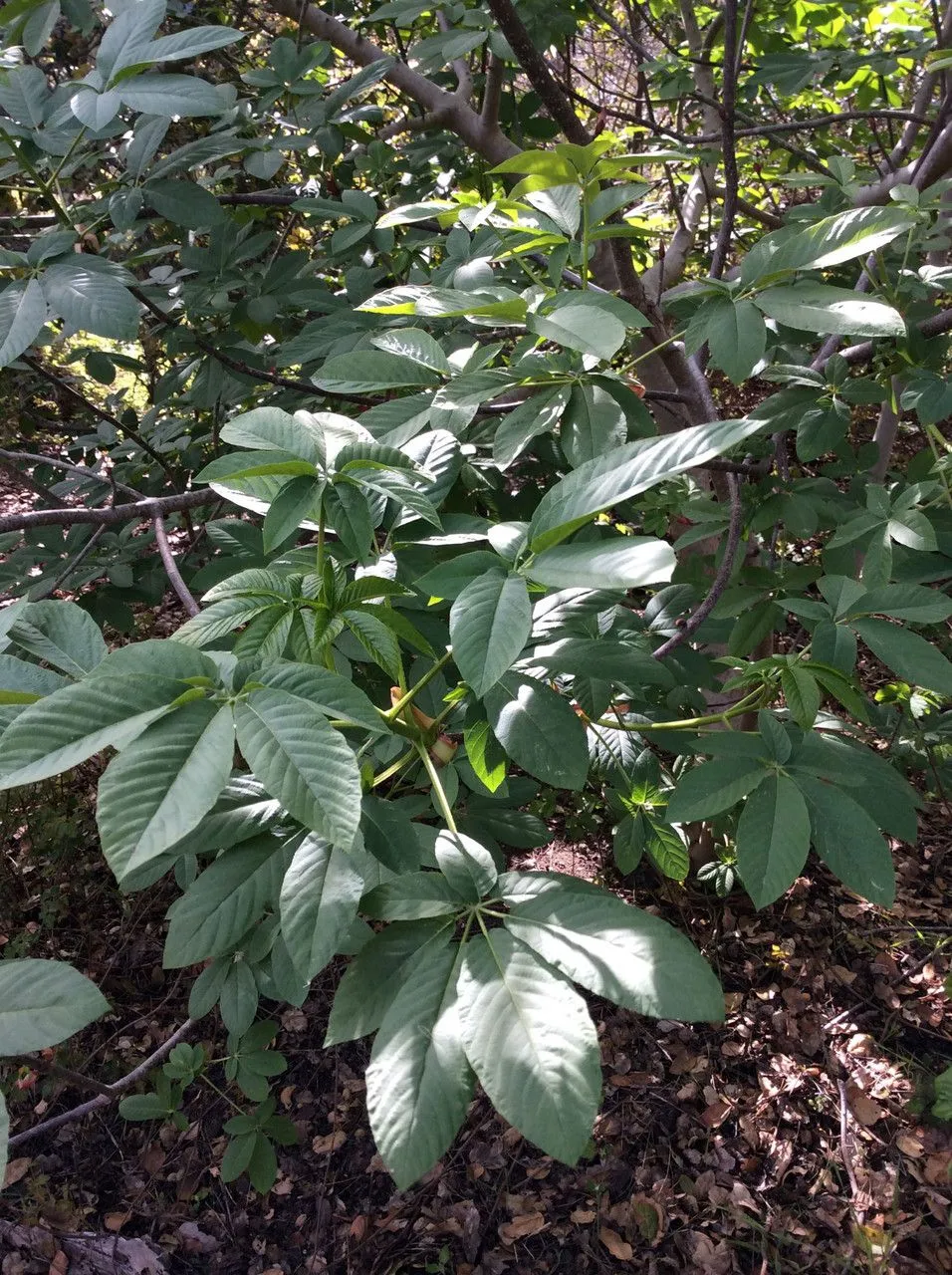
Author: (Spach) Nutt.
Bibliography: J.Torrey & A.Gray, Fl. N. Amer. 1: 251 (1838)
Year: 1838
Status: accepted
Rank: species
Genus: Aesculus
Vegetable: False
Observations: SW. Oregon to California
Aesculus californica, better known as the California buckeye, is a deciduous tree that belongs to the Sapindaceae family. This species finds its way across the picturesque landscapes from Southwestern Oregon down to the heart of California. Originating from the regions described in the early work by J.Torrey & A.Gray in 1838, the California buckeye stands out for its unique characteristics and ecological importance.
One of the most striking features of the California buckeye is its adaptability to its native environment. Thriving in a variety of habitats, from chaparral and woodlands to valleys and slopes, this tree demonstrates remarkable adaptability. Growing typically to a height of about 4-12 meters, the tree is distinguished by its large, palmately compound leaves, each comprising five to seven leaflets. The leaves emerge in early spring, gracing the landscape with their vibrant green, only to drop early in the summer to conserve water during the hot, dry season. This adaptation to the Mediterranean climate underscores the tree’s resilience.
The California buckeye is also notable for its stunning floral display. In late spring, it produces fragrant, creamy white to pinkish flowers arranged in large, erect panicles. These flowers not only add aesthetic value but also play a crucial role in the ecosystem, attracting a variety of pollinators, including bees and butterflies. However, it is important to note that all parts of the plant, particularly seeds and young shoots, contain glycosides that are toxic to humans and livestock if ingested.
As the flowering season progresses, the tree yields large, pear-shaped capsules that harbor its seeds. These seeds, known colloquially as buckeyes, are encased in a leathery husk that splits open upon maturity. While toxic, the seeds have historically found use among indigenous peoples after extensive leaching to remove their toxins.
The California buckeye serves several ecological roles beyond its aesthetic and biological functions. Its early leaf fall contributes to a nutrient-rich ground layer, promoting soil health. Moreover, in its natural habitat, the tree provides shelter and food sources for various wildlife, thereby sustaining local biodiversity.
In summary, Aesculus californica, or the California buckeye, is a remarkable tree endemic to the southwestern regions of Oregon and California. Celebrated for its botanical beauty, resilient adaptations, and ecological contributions, it remains a significant species within the Sapindaceae family.
Eng: california buckeye
Deu: kalifornische rosskastanie
En: California buckeye, Buckeye
Ar: كستناء كاليفورنيا
Bg: Калифорнийски конски кестен
Zh: 加州七葉树
Cs: Jírovec kalifornský
Fi: Kalifornianhevoskastanja
Fr: Pavier de Californie
De: Kalifornische Rosskastanie
Hu: Kaliforniai vadgesztenye
Fa: شاهبلوط آمریکایی
Zh-hant: 加州七葉樹
Uk: Гіркокаштан каліфорнійський
Taken Apr 27, 2020 by DGG DGG 2018 (cc-by-sa)
Taken May 27, 2019 by Nicolas Duivon (cc-by-sa)
Taken Jun 8, 2019 by Nick Jones (cc-by-sa)
Taken Jun 22, 2019 by perez andres (cc-by-sa)
Taken Jan 8, 2016 by Richard Lopez (cc-by-sa)
Taken Nov 24, 2022 by orangejuleas (cc-by-sa)
Taken Oct 15, 2016 by Dieter Albrecht (cc-by-sa)
Taken Oct 10, 2022 by Noël Stremsdoerfer (cc-by-sa)
Taken Dec 30, 2008 by EOL − Keir Morse (cc-by-nc-sa)
Taken Sep 19, 2021 by Paul Rousselin (cc-by-sa)
Taken Feb 13, 2014 by EOL − Brittany Burson (cc-by-nc)
Taken Feb 20, 2016 by EOL − John Menke (cc-by-nc)
Taken May 27, 2019 by Nicolas Duivon (cc-by-sa)
Taken Jul 20, 2019 by Brett Bissell someguy (cc-by-sa)
Taken Oct 15, 2016 by Dieter Albrecht (cc-by-sa)
Taken Mar 2, 2021 by Nicole M (cc-by-sa)
Taken Apr 3, 2022 by Christine Delaborde (cc-by-sa)
Taken Feb 27, 2019 by Adam King (cc-by-sa)
Taken Jul 6, 2021 by Rosi Bustamante (cc-by-sa)
Taken Sep 19, 2021 by Paul Rousselin (cc-by-sa)
Taken Feb 17, 2014 by EOL − c michael hogan (cc-by-nc-sa)
Taken Mar 10, 2020 by Michelle Michelle (cc-by-sa)
Taken Sep 17, 2021 by Alex Hayes (cc-by-sa)
Taken Feb 19, 2014 by EOL − c michael hogan (cc-by-nc-sa)
Taken Sep 19, 2021 by Paul Rousselin (cc-by-sa)
© copyright of the Board of Trustees of the Royal Botanic Gardens, Kew.
© copyright of the Board of Trustees of the Royal Botanic Gardens, Kew.
© copyright of the Board of Trustees of the Royal Botanic Gardens, Kew.
Taken Jun 2, 2018 by Daniel Barthelemy (cc-by-nc)
Taken Jun 2, 2018 by Daniel Barthelemy (cc-by-nc)
Taken Jun 2, 2018 by Daniel Barthelemy (cc-by-nc)
Taken Jun 2, 2018 by Daniel Barthelemy (cc-by-nc)
Taken Jun 2, 2018 by Daniel Barthelemy (cc-by-nc)
Growth form: Single Stem
Growth habit: Tree, Shrub
Growth rate: Moderate
Ph maximum: 7.5
Ph minimum: 5.5
Family: Myrtaceae Author: (F.Muell.) K.D.Hill & L.A.S.Johnson Bibliography: Telopea 6: 402 (1995) Year: 1995 Status:…
Family: Rubiaceae Author: Pierre ex A.Froehner Bibliography: Notizbl. Bot. Gart. Berlin-Dahlem 1: 237 (1897) Year:…
Family: Sapindaceae Author: Koidz. Bibliography: J. Coll. Sci. Imp. Univ. Tokyo 32(1): 38 (1911) Year:…
Family: Asteraceae Author: A.Gray Bibliography: Pacif. Railr. Rep.: 107 (1857) Year: 1857 Status: accepted Rank:…
Family: Fabaceae Author: Medik. Bibliography: Vorles. Churpfälz. Phys.-Ökon. Ges. 2: 398 (1787) Year: 1787 Status:…
Family: Aspleniaceae Author: (Cav.) Alston Bibliography: Bull. Misc. Inform. Kew 1932: 309 (1932) Year: 1932…